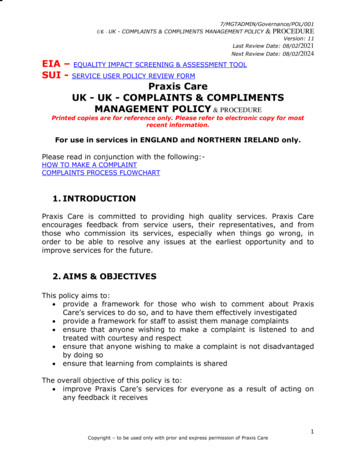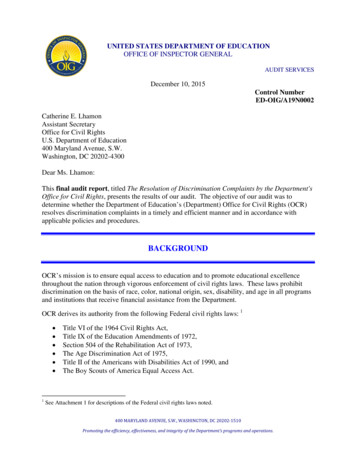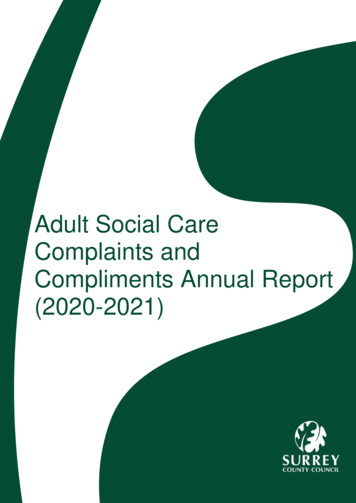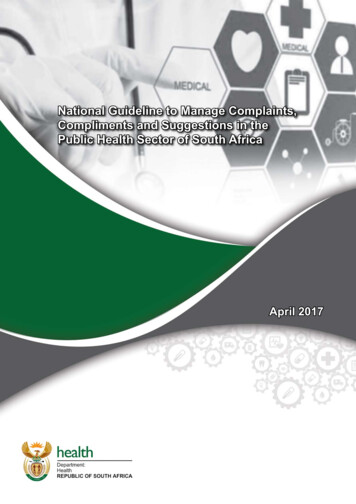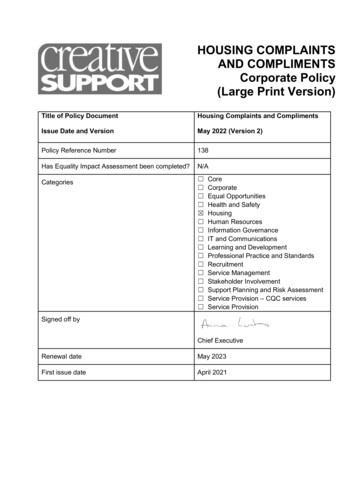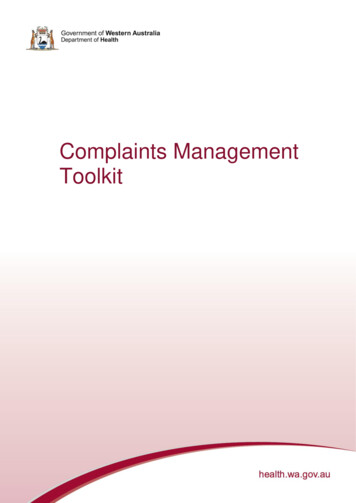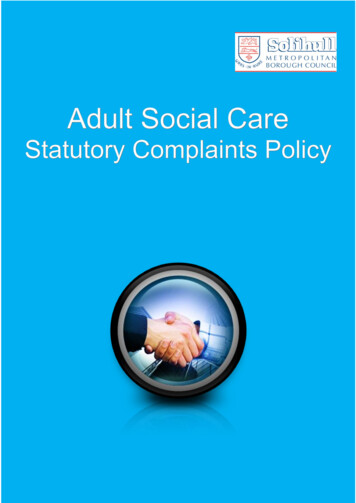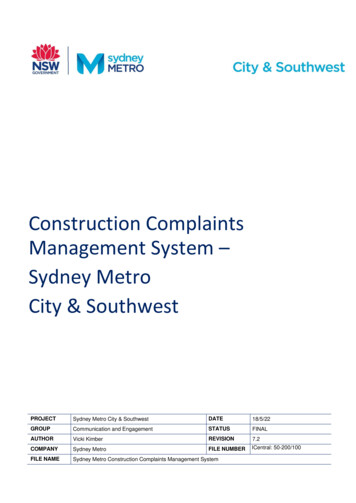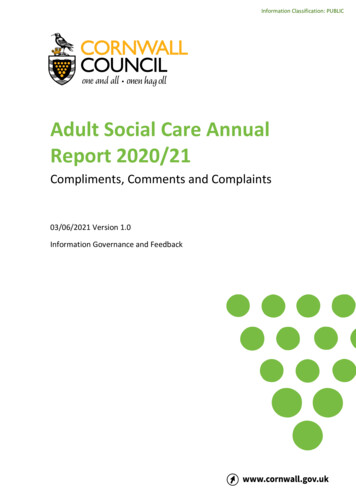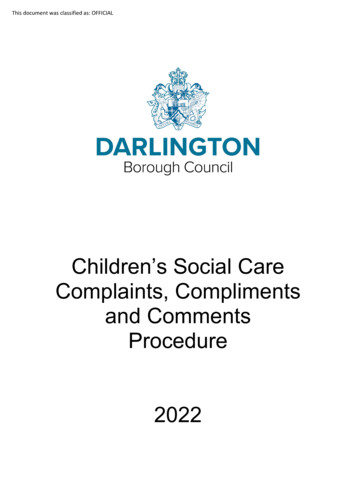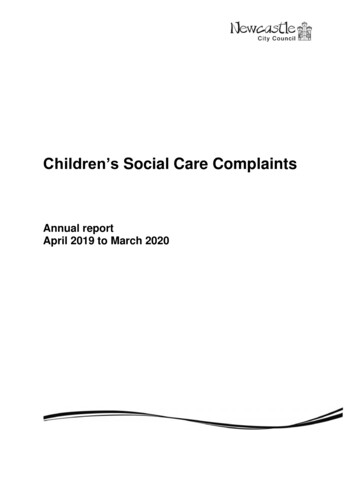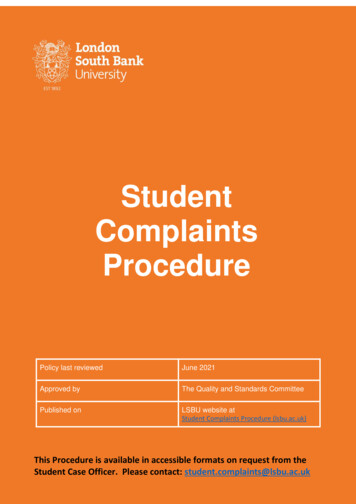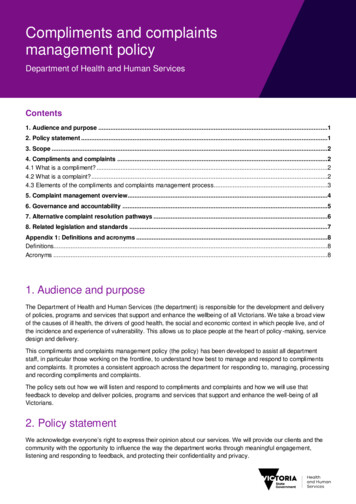
Transcription
Compliments and complaintsmanagement policyDepartment of Health and Human ServicesContents1. Audience and purpose .12. Policy statement .13. Scope .24. Compliments and complaints .24.1 What is a compliment? .24.2 What is a complaint? .24.3 Elements of the compliments and complaints management process.35. Complaint management overview.46. Governance and accountability .57. Alternative complaint resolution pathways .68. Related legislation and standards .7Appendix 1: Definitions and acronyms .8Definitions.8Acronyms .81. Audience and purposeThe Department of Health and Human Services (the department) is responsible for the development and deliveryof policies, programs and services that support and enhance the wellbeing of all Victorians. We take a broad viewof the causes of ill health, the drivers of good health, the social and economic context in which people live, and ofthe incidence and experience of vulnerability. This allows us to place people at the heart of policy -making, servicedesign and delivery.This compliments and complaints management policy (the policy) has been developed to assist all departmentstaff, in particular those working on the frontline, to understand how best to manage and respond to complimentsand complaints. It promotes a consistent approach across the department for responding to, managing, processingand recording compliments and complaints.The policy sets out how we will listen and respond to compliments and complaints and how we will use thatfeedback to develop and deliver policies, programs and services that support and enhance the well-being of allVictorians.2. Policy statementWe acknowledge everyone’s right to express their opinion about our services. We will provide our clients and thecommunity with the opportunity to influence the way the department works through meaningful engagement,listening and responding to feedback, and protecting their confidentiality and privacy.
Compliments and complaints provide valuable feedback about the level of client satisfaction with our services.Along with other forms of feedback, they provide an opportunity to improve the delivery of services. They must behandled effectively and promptly, and recorded for coordination, analysis and reporting.Resolving complaints at the earliest opportunity, in a way that respects and values the person’s feedbac k, can beone of the most important factors in ensuring an opportunity to recover a person’s positive feelings and confidenceabout our services. It can also help prevent further escalation of the complaint. To facilitate this we will provide aresponsive, efficient, effective and fair complaint management system.3. ScopeThis policy covers complaints made to the department about provided, contracted, funded or regulated servicesincluding disability services, child protection, out of home care, secure welfare, family violence, family support,housing and housing assistance, youth justice, concessions, supported residential services, alcohol and otherdrugs, mental health, community dental, community palliative care, carer’s support, home and community careservices1, screening services, pathology services, central office functions and community organisations that provideservices for, or on behalf of the department.Complaints related to services provided by funded organisations should be referred back to the organisation’scomplaint management system in the first instance, where possible. Where the matter is unable to be resolved atthis level, the complaint should be referred to the department.This policy does not cover complaints relating to hospital or health services, procurement, cemeteries andcrematoria, aged care, private hospitals, day procedure centres, bush nursing hospitals, protected disclosures,staff grievances related to their employment, or processes for a legal right of appeal, such as to the Family Court,Victorian Civil and Administrative Tribunal or Housing Appeals Unit.Separate processes are in place to manage complaints made to the Victorian Ombudsman and other externaloversight bodies. More information about the Victorian Ombudsman and other oversight bodies are available fromtheir retrospective websites.4. Compliments and complaints4.1 What is a compliment?Compliments are expressions of praise, encouragement or gratitude about services funded, contracted, regulatedor provided by the department. They provide valuable feedback about the level of satisfaction with service delivery.Compliments provide: valuable indicators of the effectiveness of a service useful insights about the aspects of service that are most meaningful to people examples of good practice which can be shared throughout the department an opportunity to recognise the efforts of staff and boost morale.Staff should acknowledge compliments and thank clients for their interest and feedback. Where possible, clientsshould be informed how the feedback will be used and assured that it will be passed on to the relevant staffmembers.4.2 What is a complaint?A complaint is defined as an expression of dissatisfaction with any service provided, contracted, funded orregulated by the department. A complaint may also be made about the complaints handling process of thedepartment.1With effect from 1 July 2016 for people under 65 years and for Aboriginal people under 50 years.Compliments and complaints management policyPage 2
A complaint relates to a specific episode, occurrence or provision of service that has resulted in an impact on anyindividual or group. A general expression of concern is not a complaint, nor is it an appealable matter.The definition of complaint used by the department is the Australian Standard Customer Satisfaction – Guidelinesfor complaints handling in organisations AS ISO 10002-2014 which defines a complaint as ‘an expression ofdissatisfaction made to or about an organisation, related to its products, services, staff or the handling of acomplaint, where a response or resolution is explicitly or implicitly expected’.4.3 Elements of the compliments and complaints management processThe department’s compliment and complaint management process is based on the following elements:Visibility and accessibilityThe management system will be visible and accessible to individuals and: explain how and where to make a compliment or complaint, including an anonymous complaint consider specific needs of the individual or barriers they may experience explain alternative complaint resolution pathways when the complaint is first lodged and when it is closed explain how the department will manage a complaint and the expected timeframe for resolution support individuals so they can identify and seek their preferred outcome.ResponsivenessThe management system will be responsive and provide mechanisms and strategies to: promote client rights, particularly those with special support needs, so they can actively participate in thecompliments and complaints process inform and train staff to use the compliment and complaint management system support the complainant to seek the most appropriate resolution ensure there is clarity about the requested outcome provide a respectful, valuing and informative acknowledgement actively listen, empathising and acknowledging when the service was not the best it could have been monitor timeframes for resolution communicate with all relevant parties about the progress to resolve the complaint.Assessment and investigationThe management system will have mechanisms and strategies to: assess complaints for severity, safety, complexity, impact and the need for immediate action collect adequate and appropriate information to inform systemic improvement protect the privacy and confidentiality of the information people have provided determine by whom and at what level the complaint should be dealt with enable complaints to be considered independently, fairly and objectively.FeedbackThe management system will provide mechanisms and strategies to: explain what happened and why, what will be done to fix the issue, who will do it, how we will communicate ourprogress and how we will check things are on track explain the reasons for the decision provide an apology where an apology is provided, ensure it is sincere, and accepts responsibility for what occurred and the impactCompliments and complaints management policyPage 3
explain the circumstances without making excuses, and summarise the key actions that will be taken provide regular updates to the complainant if the resolution is delayed notify the complainant of alternative complaint resolution pathways and review mechanisms follow up with complainants to determine the effectiveness of the outcome, where appropriate.Improvement focussedThe management system will provide mechanisms and strategies to gather and record feedback and otherinformation to: meet any statutory, policy or procedural reporting requirements improve the training and capabilities of complaint management staff analyse the complaint data and identify complaint trends for performance improvement monitor the time taken to resolve complaints notify service providers of any changes necessary arising from a complaint as part of a continuous qualityimprovement approach.Note: For the purpose of this document, all privacy incidents / complaints / breaches that relate to a client aremanaged according to existing department instructions.5. Complaint management overviewThe department’s complaint management process promotes the resolution of complaints at the local level prior toissues being escalated to higher levels of management. The complaint management tiers are shown in Figure 1below.Figure 1: Complaint management tiersNote: Depending on the level of complexity, a complaint can immediately be assessed as Tier 2 or Tier 3.The complaint management process is shown in Figure 2 below.Compliments and complaints management policyPage 4
Figure 2: Complaint management process6. Governance and accountabilityAccountabilities and responsibilities that underpin the effective implementation of this policy are as follows:Table 1: Listing of units and responsibilitiesUnitActions and responsibilityComplaints and PrivacyUnit (CPU), ExecutiveServices & Oversightbranch establishes, monitors and reviews all compliments and complaintsmanagement related policies and processes provides reports on complaints volume, practice and intelligence to thedepartment’s Board, Ministers, and external oversight bodies manages and coordinates Tier 3 complaints that require investigationindependent of the relevant division (following consultation with therelevant divisions, area-based and regional service streams todetermine the appropriate lead for investigation) audits the complaints management system identifies trends and systemic issues in compliments and complaints manages a central complaints telephone and email service, includingregistering, reviewing and referring complaints provides education, training advice and support to divisions and areasrelating to the compliments and complaints management policy andpractice manages the Response, Incident, Emergency Management System(RIEMS) and provides support for users of the systemCompliments and complaints management policyPage 5
UnitActions and responsibilityDivisional Performance,Quality and Compliance(PQ&C) units provides divisional staff with RIEMS access and training provides education, training advice and support to divisional staff inregards to the compliments and complaints process manages and coordinates Tier 3 complaints following consultation withCPU, relevant divisions, area-based and regional service streams todetermine the appropriate lead for investigation provides support and advice to divisional staff relating to complimentsand complaints management policy and practice reports on divisional complaints data and management acts as the key liaison for the division with CPUDivisional, Area-based andRegional Service Streams2 maintains a point of contact for the reception, processing andcoordination of compliments and complaints ensures compliment and complaint management policies andprocedures are implemented ensures the promotion, awareness and monitoring of the processes ensures that information about processes is readily accessible to staffand clients ensures that compliments and complaints are recorded for effectivemanagement, record keeping and reporting ensures that front line staff have appropriate training and authorisationto resolve complaints ensures that agreed resolution actions are implemented ensures that staff who work directly with clients are appropriately trainedand authorised to resolve matters ensures their staff record and process compliments and complaintspromptly in accordance with policy and as close as possible to the firstpoint of contact promotes the department’s approach to managing compliments andcomplaintsAll staff be aware of their roles, responsibilities, authorities and procedures accept accountability for receiving, recording and reporting complimentsand complaints7. Alternative complaint resolution pathwaysA number of alternative pathways exist to resolve complaints. These pathways include legislated processes,external review processes and internal departmental processes. Most legislated processes involve the examinationof complaints or grievances received by an external body. External review authorities that may accept complaintsand refer them to the department for action include the following: Victorian Auditor-General’s Office Victorian Workcover Authority Victorian Ombudsman Independent Broad-based Anti-corruption Commission Disability Services Commissioner Health Services Commissioner2All Department of Health and Human Services divisions, areas and regions, including Central Office functionsCompliments and complaints management policyPage 6
Mental Health Complaints Commissioner Victorian Privacy Commissioner Housing Registrar Freedom of Information Commissioner Children’s Court and/or Family Court Commission for Children and Young People Victorian Civil and Administrative Tribunal Victorian Equal Opportunities and Human Rights Commission.8. Related legislation and standardsThis policy is informed by the following legislation: Ombudsman Act 1973 Freedom of Information Act 1982 Housing Act 1983 Privacy and Data Protection Act 2014 Health Records Act 2001 Health Services Act 1988 Mental Health Act 2014 Public Administration Act 2004 Children, Youth and Families Act 2005 Charter of Human Rights and Responsibilities Act 2006 Disability Act 2006 Protected Disclosure Act 2012 Commission for Children and Young People Act 2012.Compliments and complaints management policyPage 7
Appendix 1: Definitions and acronymsDefinitionsTermMeaningAcknowledgementA notification to a client that their compliment or complaint has beenreceived, and informing them of the process and anticipated time ofresolutionClient/Service UserAn organisation or person that receives a product or service provided,contracted, funded or regulated by the department.ComplaintA complaint is defined as an expression of dissatisfaction with any serviceprovided, contracted, funded or regulated by the department.A complaint relates to a specific episode, occurrence or provision of servicethat has resulted in an impact on any individual or group. A generalexpression of concern is not a complaint, nor is it an appealable matter.ComplimentCompliments are expressions of praise, encouragement or gratitude aboutservices funded, contracted, regulated or provided by the department.AcronymsTermMeaningCPUComplaints and Privacy UnitCOSIClient Outcomes and Service Improvement (located in operationaldivisions)RIEMSResponse, Incident, Emergency Management SystemTo receive this publication in an accessible format phone 1300 884 706, using the NationalRelay Service 13 36 77 if required, or email complaints.reception@dhhs.vic.gov.auWhere the term ‘Aboriginal’ is used it refers to both Aboriginal and Torres Strait Islander people. Indigenous isretained when it is part of the title of a report, program or quotation.Authorised and published by the Victorian Government, 1 Treasury Place, Melbourne. State of Victoria, Department of Health and Human Services November, 2016.ISBN 978-0-7311-7076-0 (online)Available at ments and complaints management policyPage 8
The management system will provide mechanisms and strategies to gather and record feedback and other information to: meet any statutory, policy or procedural reporting requirements improve the training and capabilities of complaint management staff analyse the complaint data and identify complaint trends for performance improvement
